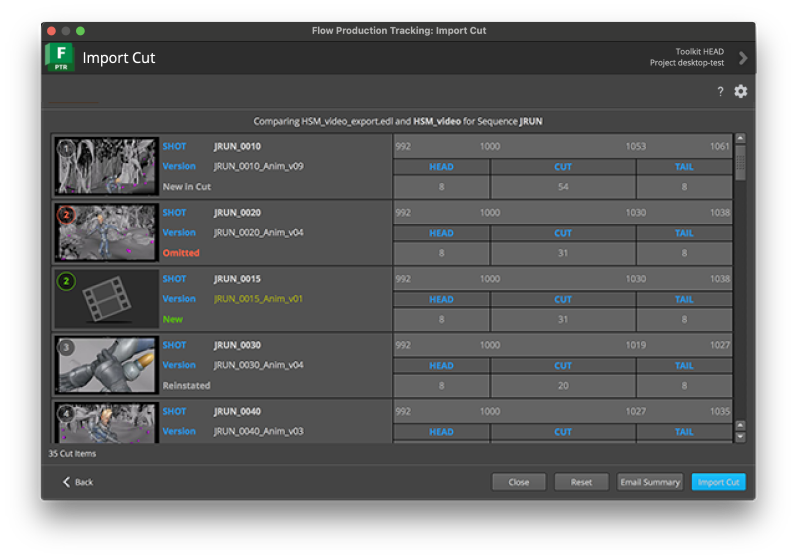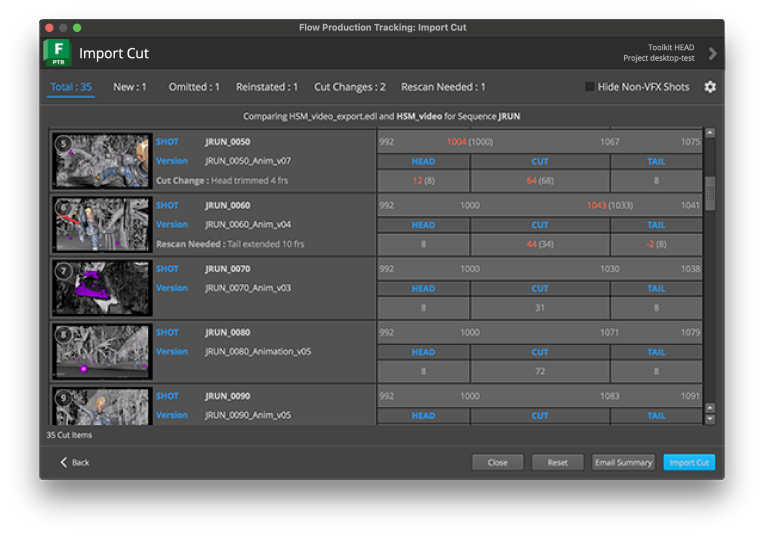Understanding cut changes
Figuring out what changed in a new EDL can be a tedious and manual process, mistake-prone, and time-consuming. the Import Cut Tool removes the busywork and quickly auto-generates a summary of potential changes to Shots in the EDL compared to the latest information in Flow Production Tracking. Jump ahead straight to the most important steps—reviewing the proposed Cut changes, updating the data in Flow Production Tracking, and notifying the rest of your team.
Types of changes
The Import Cut Tool reports on five key types of changes:

New Shots
Shots in the EDL that do not match up to an existing Shot for the Project in Flow Production Tracking are considered New Shots. The Import Cut Tool creates these Shots in Flow Production Tracking as part of the import. New Shots also have a sub-category, New in Cut, which applies to a Shot in the EDL that does match up in Flow Production Tracking but was not in the previous Cut being compared.
Omitted Shots
When comparing the EDL to a previous Cut, the Import Cut Tool will call out Shots in the previous Cut that are not in the EDL as Omitted Shots. This typically means that the Shots in question may not need to be worked on anymore since they are out of the Cut. The app can also optionally update the status of the Shot in Flow Production Tracking as part of the import based on your settings to save you from having to do it manually and help get the information updated as soon as possible in the system for the rest of the team.
Reinstated Shots
Similar to the treatment for Omitted Shots, the Import Cut Tool will call out Shots in the EDL that currently have an omit status in Flow Production Tracking as Reinstated Shots. This typically means that the Shots in question were formerly out of the Cut, but are now back in, and work should resume on them. The app can also optionally update the status of the Shot in Flow Production Tracking as part of the import, based on your settings, to save you from having to do it manually and help get the information updated as soon as possible in the system for the rest of the team.

Cut Changes
Recognizing when the new Cut In and Cut Out values for Shots in the EDL differ from the previous values in Flow Production Tracking is a key feature of Import Cut. When either or both of these values change inside of the handles for the Shots, meaning Cut In is still greater than Head In and Cut Out is still less than Tail Out, they will be considered Cut Changes. Since the working frame range of the Shot, which includes the handles, still covers the Cut frame range, the new information may not impact the team’s progress going forward. Any modified in point, out point, or frame duration value from the EDL that will be highlighted in red text, with the previous value in parenthesis.
Rescan Needed
However, when the Cut In or Cut Out values for Shots in the EDL change beyond the handles for the Shots, the Import Cut Tool will label them as Rescan Needed. The app separates them because here, the team may not have enough frames of their scanned plate elements to complete their work, given that the new desired Cut frame range exceeds the previous working frame range. As with Cut Changes, any modified in point, out point, or frame duration value from the EDL that will be highlighted in red text, with the previous value in parenthesis. Negative values for handles represent the number of frames beyond the previous duration based on the EDL.
Cut Order
It’s worth noting that while the Import Cut Tool will populate the Cut Order fields in Flow Production Tracking to help with page sorting, it does not report on changes to the Cut Order in an EDL. To keep the summary view as simple and easy-to-read as possible, only changes related to existence and frame range in a Cut are displayed.
